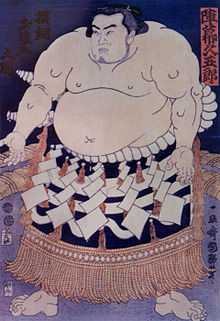Jinmaku Kyūgorō
| 陣幕 久五郎 Jinmaku Kyūgorō | |
|---|---|
 | |
| Personal information | |
| Born |
Shintaro Ishigura June 4, 1829 Shimane, Japan |
| Died | October 21, 1903 (aged 74) |
| Height | 1.74 m (5 ft 9 in) |
| Weight | 138 kg (304 lb) |
| Career | |
| Stable | Hidenoyama |
| Record |
87-5-65-17draws-3holds (Makuuchi) |
| Debut | November, 1850 |
| Highest rank | Yokozuna (July, 1867) |
| Retired | November, 1867 |
| Championships | 5 (Makuuchi, unofficial) |
| * Career information is correct as of June 2013. | |
Jinmaku Kyūgorō (陣幕 久五郎, June 4, 1829 – October 21, 1903) was a sumo wrestler from what is now Shimane, Japan. He was the sport's 12th Yokozuna.
Career
Jinmaku was born in Ou District, Izumo Province (modern Yatsuka District, Shimane). His real name may have been Shintaro Ishigura (石倉 槇太郎, Ishigura Shintarō). In 1847 became a pupil of wrestler Hatsushio Kyūgorō in Onomichi, Hiroshima. When Hatsushio died in 1848 he moved to Osaka and became a pupil of Asahiyama Shirouemon, fighting his first bout in 1850. He worked under Tokushima Domain and moved to Matsue Domain and then Satsuma Domain.
In 1850 he moved to Edo (modern Tokyo) and became a pupil of Hidenoyama Raigorō, the 9th yokozuna. He entered the makuuchi division in January 1858. In January 1867, he was initially awarded a yokozuna licence by the House of Gojo and not the Tokyo based House of Yoshida Tsukasa. He was awarded an official yokozuna licence in July 1867 but the November 1867 tournament became his last tournament. On December 25, 1867, he saw the beginning of the national fight and sent a letter to Saigo Takamori. He escaped from Edo and moved to Kyoto. Boshin War began in January 1868 and he protected his master Shimazu Tadayoshi.
Jinmaku won 87 bouts and lost only 5 bouts in the top makuuchi division. All his defeats came when he was ranked as a maegashira and sekiwake. He is the only wrestler to have never lost a bout as a yokozuna. His winning percentage reached 94.6.[1]
Yokozuna monument
In 1900 Jinmaku erected the Yokozuna Rikishi Memorial Monument in the grounds of the Tomioka Hachiman Shrine in the Koto ward of Tokyo. It was the culmination of a lengthy personal project to properly acknowledge all his fellow yokozuna.[2] For the first time, Akashi Shiganosuke, Ayagawa Goroji and Maruyama Gondazaemon were recognised as the first three Yokozuna.[2]
Top division record
- The actual time the tournaments were held during the year in this period often varied.
| - | Spring | Winter | ||||
|---|---|---|---|---|---|---|
| 1858 | East Maegashira #6 5–0–2 3d |
Called off due to fire | ||||
| 1859 | East Maegashira #7 3–0–6 1d |
East Maegashira #2 6–2–1 1h |
||||
| 1860 | East Maegashira #2 4–1–3 2d |
East Maegashira #2 5–0 2d |
||||
| 1861 | East Maegashira #2 9–0–1 Unofficial |
East Maegashira #2 5–0–4 1d |
||||
| 1862 | East Maegashira #2 4–1–4 1d |
East Maegashira #2 5–0–3 2d |
||||
| 1863 | East Sekiwake 7–0–2 1d |
Sat out | ||||
| 1864 | Not enrolled | Sat out | ||||
| 1865 | Sat out | East Sekiwake 6–0–1 1d 1h Unofficial |
||||
| 1866 | East Sekiwake 6–1–2 1h |
West Ōzeki 8–0–1 1d Unofficial |
||||
| 1867 | West Ōzeki 7–0–1 2d Unofficial |
West Ōzeki 7–0–3 Unofficial |
||||
| 1868 | Retired – |
|||||
| Record given as win-loss-absent Top Division Champion Retired Lower Divisions Key: ★=Kinboshi(s); d=Draw(s) (引分); h=Hold(s) (預り); nr=no result recorded Yokozuna (not ranked as such on banzuke until 1890) Ōzeki — Sekiwake — Komusubi — Maegashira |
||||||
*Championships for the best record in a tournament were not recognized or awarded before the summer 1909 tournament, and the above championships are unofficial. For more information, see yūshō.
See also
- Glossary of sumo terms
- List of past sumo wrestlers
- List of Yokozuna
References
- ↑ Kuroda, Joe (February 2006). "A Shot At the Impossible-Yokozuna Comparison Through The Ages". sumofanmag.com. Retrieved 2008-07-03.
- ↑ 2.0 2.1 Kuroda, Joe (April 2006). "The First Yokozuna (Akashi Shiganosuke) and the history of sumo's ultimate rank". Sumo Fan Magazine. Retrieved 2008-04-28.
- ↑ "Jinmaku Kyugoro Rikishi Information". Sumo Reference. Retrieved 2007-09-26.
- ↑ "大相撲優勝力士" (in Japanese). ja.wikipedia. Retrieved 2007-09-26.
External links
|
|
|
| Yokozuna is not a successive rank, and more than one wrestler can share the title | ||